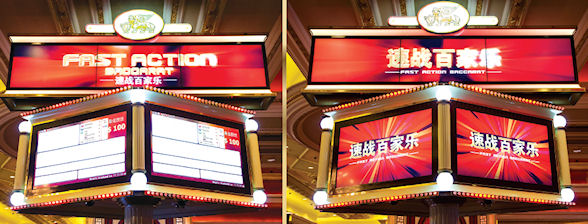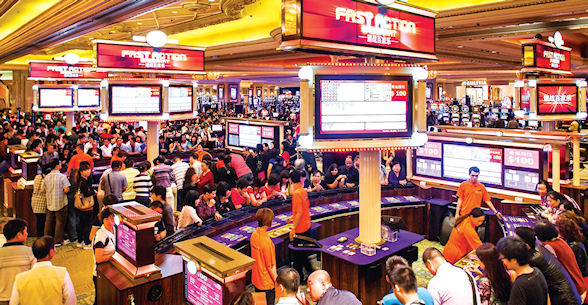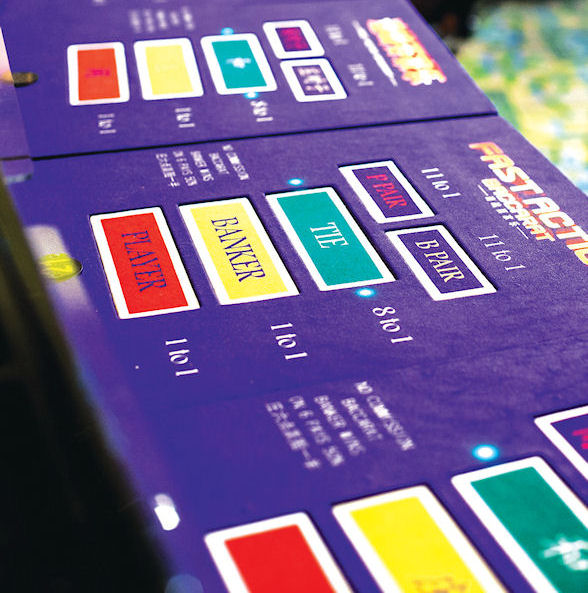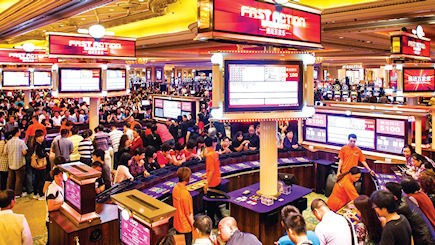This article first appeared in the May/Jun 2014 issue of World Gaming magazine.
With the ever-present specter of Macau’s gaming table cap placing added presure on casino operators as they try to satisfy the huge demand among Chinese players for baccarat, baccarat and more baccarat, the Venetian unveiled an innovative solution when it launched Fast Action Baccarat in late 2012. It has proved to be a huge success.

As the old saying goes, a fast game is a good game, and that’s certainly the theory at the Venetian Macao where their innovative Fast Action Baccarat (FAB) has proved a resounding success since it was first launched almost 18 months ago.
Just as the name says, FAB is all about speed – the giant 21-foot long tables are designed not only to accommodate more players but also to deal more hands per hour than a standard baccarat table. In fact, even with 28 separate betting positions at each table and the capacity for up to 60 standing players at any one time, FAB is averaging around 70 hands per hour compared with 45 to 50 hands with traditional baccarat.
Not surprisingly, Sands China Ltd (SCL) came in for criticism from some quarters when FAB was first launched in December 2012 with some suggesting it was simply a means of skirting around Macau’s controversial table cap. But the fact remains that with baccarat far and away the game of choice for Macau’s gamblers – having accounted for a phenomenal 91.5 percent of gaming revenue in 2013 according to official DICJ figures – it makes sense to give players what they want.
So how does it work? Let’s start with the dealers. Unlike a standard baccarat table which features a single dealer, FAB has three dealers at each table whose tasks range from dealing the cards to awarding payouts and checking players’ bets. The 28 betting positions surround a central dealing station with a live video feed displaying each hand on several monitors positioned around the table.

Players place their bets on either “banker” or “player” (or tie) as usual but rather than the dealers having to go to each betting space to collect losing bets, trap doors built into the tables drop open with chips falling onto a conveyer built which transports them to the chip sorter. Winning bets are paid out individually but again time is saved by the presence of mobile chip trays which move along glide rails with the dealer.
And to ensure play carries on at a cracking pace, FAB is both “face-up” and No Commission. In other words, instead of players being offered the opportunity to squeeze the cards – a popular but time-consuming preference of many experienced baccarat players – the dealers deal each hand face-up on the central dealing station with players not allowed to touch the cards. The No Commission version of the game also means there is no need for dealers to calculate the five percent commission on winning Banker bets.
Much like the decision to go face-up, No Commission baccarat – which offers a slightly higher house edge – is far from the preferred option for experienced or high stakes player, but then FAB is more about appealing to the mass market than catering to the specific wants of each individual player. With that in mind, FAB also has the great advantage of being able to offer lower minimum bets – players can bet as little as HK$100 per hand if they so wish as opposed to lowest bets of around HK$500 in most of Macau’s major casinos, so it’s a great option for those wanting to enjoy the fun and excitement of a crowded baccarat table without breaking the bank.
For SCL, developing these complex new tables took a good 12 months of trial and error before the development team was satisfied with the finished product, although much of the credit must go to Las Vegas Sands‘ Senior Vice President and Chief Casino Officer Andrew MacDonald who first came up with the idea during a meeting in his Singapore office.
We were talking about layout submissions and game optimization,” MacDonald explained to WGM. “In many casino jurisdictions the layout of the game is specified in the Approved Game Rules. We were talking about why you couldn’t have just one betting position approved and then replicate it multiple times – say from one to 100. That sparked a discussion which noted that optimal utilization on tables related to bet speed degradation as more players were added.
“We leapt from there to talking about multiple spots, trapdoors, conveyors and chipping machines all within a few minutes – how to build an efficient table with so many betting positions. An idea was born from a fun five minute discussion.”
We at WGM can’t help but notice some similarities between FAB and the Australian casino game of two-up – another game which involves a crowd of standing people surrounding a betting ring.

Perhaps the secret to FAB’s success in Macau is that it plays directly to the preference of many Chinese to gamble together, rather than sitting at a table alone. Gaming in general is widely seen as a social activity and it’s common to see crowds three and four people deep crowded around a baccarat table – some of them betting, others simply keen to be a part of the excitement.
By sheer size alone, FAB tables allow more people to gather and take part. As SCL’s Senior Vice President of Gaming Operations, Cetin Tanisman, explained, “Traditionally, baccarat is a game where players play together in mass gaming areas and obviously to create a gaming table capable of accommodating more than 30 players allowed us to increase the level of energy and excitement on the gaming floor and allow players to enjoy a unique gaming experience at a lower price point.
“It’s been very well received and we’re constantly getting positive feedback from the players.”
Whether or not this style of gaming – larger tables offering faster gaming to more people – is the way of the future remains to be seen, but with SCL having recently expanded from four tables to 12 between their Venetian and Sands Cotai Central properties, one thing is for certain … FAB is here to stay.







